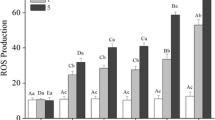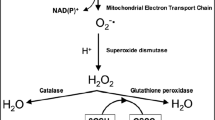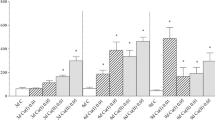Abstract
This study aimed to investigate the effects of hypoxia on Cu-induced antioxidant defense, Cu transport, and mitophagy in the liver of the large yellow croaker. Fish were exposed to hypoxia (3.0 mg L−1), Cu (120 μg L−1), and hypoxia (3.0 mg L−1) plus Cu (120 μg L−1) for 48 h. Hypoxia exposure increased antioxidant abilities to maintain cellular redox balance. Although Cu exposure alone improved antioxidant defense, Cu transport, and mitophagy, these stress responses could not completely neutralize Cu toxicity, as reflected by the elevated reactive oxygen species (ROS) and lipid peroxidation (LPO) and hepatic vacuoles. When compared with Cu stress alone, hypoxia increased Cu toxicity by inhibiting antioxidant defense, Cu transport, and mitophagy, leading to the increment of mortality, ROS, and LPO, and the deterioration of histological structure. The adverse effects of hypoxia on Cu-induced metal transport and mitophagy might be involved in metal-responsive element-binding transcription factor-1 (MTF-1) and Forkhead box O-3 (FoxO3) signaling pathways, respectively. Overall, hypoxia reduced antioxidant response, Cu transport, and mitophagy in fish exposed to Cu, which contributes to understanding the molecular mechanisms underlying negative effects of hypoxia on Cu toxicity in fish.






Similar content being viewed by others
References
Aebi H (1984) [13] Catalase in vitro. Methods Enzymol 105:121–126
Aich A, Chattopadhyay B, Mukhopadhyay SK (2017) Immunolocalization of metallothionein in hepatocytes of guppy fish (Poecilia reticulata) exposed to tannery effluent: a biomarker study. Chemosphere 169:460–466
Amiard JC, Amiard-Triquet C, Barka S, Pellerin J, Rainbow PS (2006) Metallothioneins in aquatic invertebrates: their role in metal detoxification and their use as biomarkers. Aquat Toxicol 76:160–202
Ashrafi G, Schwarz TL (2013) The pathways of mitophagy for quality control and clearance of mitochondria. Cell Death Differ 20:31–42
BhansaliS BA, Dhawan V (2017) Favourable metabolic profile sustains mitophagy and prevents metabolic abnormalities in metabolically healthy obese individuals. Diabetol Metab Syndr 9:99
Blewett TA, Simon RA, Turko AJ, Wright PA (2017) Copper alters hypoxia sensitivity and the behavioural emersion response in the amphibious fish Kryptolebias marmoratus. Aquat Toxicol 189:25–30
Bradford MM (1976) A rapid and sensitive method for the quantitation of microgram quantities of protein utilizing the principle of protein-dye binding. Anal Biochem 72:248–254
Braz-Mota S, Campos DF, MacCormack TJ, Duarte RM, Val AL, Almeida-Val VM (2018) Mechanisms of toxic action of copper and copper nanoparticles in two Amazon fish species: dwarf cichlid (Apistogramma agassizii) and cardinal tetra (Paracheirodon axelrodi). Sci Total Environ 630:1168–1180
Chen CC, Gong GC, Shiah FK (2007) Hypoxia in the East China Sea: one of the largest coastal low-oxygen areas in the world. Mar Environ Res 64:399–408
Chen F, Huang C, Luo Z, Shi X, Liu X, Fan YF, Pan YX (2016) Fe reduced hepatic lipid deposition in Synechogobius hasta exposed to waterborne Cu. Aquat Toxicol 174:134–145
Coto-Montes A, Boga JA, Rosales-Corral S, Fuentes-Broto L, Tan DX, Reiter RJ (2012) Role of melatonin in the regulation of autophagy and mitophagy: a review. Mol Cell Endocrinol 361:12–23
da Silva ES, Abril SIM, Zanette J, Bianchini A (2014) Salinity-dependent copper accumulation in the guppy Poecilia vivipara is associated with CTR1 and ATP7B transcriptional regulation. Aquat Toxicol 152:300–307
Di Y, He YL, Zhao T, Huang X, Wu KW, Liu SH, Zhao YQ, Fan M, Wu LY, Zhu LL (2015) Methylene blue reduces acute cerebral ischemic injury via the induction of mitophagy. Mol Med 21:420–429
Diebold L, Chandel NS (2016) Mitochondrial ROS regulation of proliferating cells. Free Radical Bio Med 100:86–93
Dodson M, Redmann M, Rajasekaran NS, Darley-Usmar V, Zhang J (2015) KEAP1-NRF2 signalling and autophagy in protection against oxidative and reductive proteotoxicity. Biochem J 469:347–355
Dolci GS, Vey LT, Schuster AJ, Roversi K, Roversi K, Dias VT, Pase CS, Barcelos RCS, Antoniazzi CTD, Golombieski JI, Glanzner WG, Anezi Junior PA, Gonçalves PBD, Nunes MAG, Dressler VL, Baldisserotto B, Burger ME (2014) Hypoxia acclimation protects against oxidative damage and changes in prolactin and somatolactin expression in silver catfish (Rhamdia quelen) exposed to manganese. Aquat Toxicol 157:175–185
Donnelly PS, Liddell JR, Lim S, Paterson BM, Cater MA, Savva MS, Mot AI, James JL, Trounce IA, White AR, Crouch PJ (2012) An impaired mitochondrial electron transport chain increases retention of the hypoxia imaging agent diacetylbis (4-methylthiosemicarbazonato) copperII. P Natl Acad Sci USA 109:47–52
Drotar A, Phelps P, Fall R (1985) Evidence for glutathione peroxidase activities in cultured plant cells. Plant Sci 42:35–40
Fang EF, Scheibye-Knudsen M, Chua KF, Mattson MP, Croteau DL, Bohr VA (2016) Nuclear DNA damage signalling to mitochondria in ageing. Nat Rev Mol Cell Biol 17:308
Fitzgerald JA, Jameson HM, Dewar Fowler VH, Bond GL, Bickley LK, Uren Webster TM, Bury NR, Wilson RJ, Santos EM (2016) Hypoxia suppressed copper toxicity during early development in zebrafish embryos in a process mediated by the activation of the HIF signaling pathway. Environ Sci Technol 50:4502–4512
Fitzgerald JA, Katsiadaki I, Santos EM (2017) Contrasting effects of hypoxia on copper toxicity during development in the three-spined stickleback (Gasterosteus aculeatus). Environ Pollut 222:433–443
Gu X, Xu Z (2011) Effect of hypoxia on the blood of large yellow croaker (Pseudosciaena crocea). Chin J Oceanol Limnol 29:524–530
Hardyman JEJ, Tyson J, Jackson KA, Aldridge C, Cockell SJ, Wakeling LA, Valentine RA, Ford D (2016) Zinc sensing by metal-responsive transcription factor 1 (MTF1) controls metallothionein and ZnT1 expression to buffer the sensitivity of the transcriptome response to zinc. Metallomics 8:337–343
Holmstrup M, Bindesbøl AM, Oostingh GJ, Duschl A, Scheil V, Köhler HR, Loureiro S, Gerhardt A (2010) Interactions between effects of environmental chemicals and natural stressors: a review. Sci Total Environ 408:3746–3762
Hosseini MJ, Shaki F, Ghazi-Khansari M, Pourahmad J (2014) Toxicity of copper on isolated liver mitochondria: impairment at complexes I, II, and IV leads to increased ROS production. Cell Biochem Biophys 70:367–381
Howarth R, Chan F, Conley DJ, Garnier J, Doney S, Marino R, Billen G (2011) Coupled biogeochemical cycles: eutrophication and hypoxia in temperate estuaries and coastal marine ecosystems. Front Ecol Environ 9:18–26
Jayakumar S, Pal D, Sandur SK (2015) Nrf2 facilitates repair of radiation induced DNA damage through homologous recombination repair pathway in a ROS independent manner in cancer cells. Mutat Res-Fund Mol M 779:33–45
Joint FAO (2012) WHO Expert Committee on Food Additives, World Health Organization. Safety evaluation of certain food additives and contaminants: prepared by, In: Proceedings of the Seventy fourth meeting of the Joint FA
Jomova K, Baros S, Valko M (2012) Redox active metal-induced oxidative stress in biological systems. Transit Met Chem 37:127–134
Kovac S, Angelova PR, Holmström KM, Zhang Y, Dinkova-Kostova AT, Abramov AY (2015) Nrf2 regulates ROS production by mitochondria and NADPH oxidase. BBA-Gen Subjects 1850:794–801
Kuschel A, Simon P, Tug S (2012) Functional regulation of HIF-1α under normoxia—is there more than post-translational regulation? J Cell Physiol 227:514–524
La Fontaine S, Mercer JF (2007) Trafficking of the copper-ATPases, ATP7A and ATP7B: role in copper homeostasis. Arch Biochem Biophys 463:149–167
Le Croizier G, Lacroix C, Artigaud S, Le Floch S, Raffray J, Penicaud V, Coquillé V, Autier J, Rouget M-L, Bayon NL, Laë R, De Morais LT (2018) Significance of metallothioneins in differential cadmium accumulation kinetics between two marine fish species. Environ Pollut 236:462–476
Le TY, Zimmermann S, Sures B (2016) How does the metallothionein induction in bivalves meet the criteria for biomarkers of metal exposure? Environ Pollut 212:257–268
LeBel CP, Ischiropoulos H, Bondy SC (1992) Evaluation of the probe 2′, 7′ -dichlorofluorescin as an indicator of reactive oxygen species formation and oxidative stress. Chem Res Toxicol 5:227–231
Li L, Tan J, Miao Y, Lei P, Zhang Q (2015) ROS and autophagy: interactions and molecular regulatory mechanisms. Cell Mol Neurobiol 35:615–621
Liu XJ, Luo Z, Xiong BX, Liu X, Zhao YH, Hu GF, Lv GJ (2010) Effect of waterborne copper exposure on growth, hepatic enzymatic activities and histology in Synechogobius hasta. Ecotox Environ Safe 73:1286–1291
Livingstone DR, Martinez PG, Michel X, Narbonne JF, O’hara S, Ribera D, Winston GW (1990) Oxyradical production as a pollution-mediated mechanism of toxicity in the common mussel, Mytilus edulis L., and other molluscs. Funct Ecol 3:415–424
Lu W, Sun J, Yoon JS, Zhang Y, Zheng L, Murphy E, Mattson MP, Lenardo MJ (2016) Mitochondrial protein PGAM5 regulates mitophagic protection against cell necroptosis. PLoS One 11:e0147792
Nakano M, Kimura H, Hara M, Kuroiwa M, Kato M, Totsune K, Yoshikawa T (1990) A highly sensitive method for determining both Mn-and Cu/Zn superoxide dismutase activities in tissues and blood cells. Anal Biochem 187:277–280
Napolitano G, Venditti P, Fasciolo G, Esposito D, Uliano E, Agnisola C (2019) Acute hypoxia/reoxygenation affects muscle mitochondrial respiration and redox state as well as swimming endurance in zebrafish. J Comp Physiol B 189:97–108
Pan K, Wang WX (2012) Trace metal contamination in estuarine and coastal environments in China. Sci Total Environ 421:3–16
Pan YX, Luo Z, Zhuo MQ, Wei CC, Chen GH, Song YF (2018) Oxidative stress and mitochondrial dysfunction mediated Cd-induced hepatic lipid accumulation in zebrafish Danio rerio. Aquat Toxicol 199:12–20
Pfaffl MW (2001) A new mathematical model for relative quantification in real-time RT-PCR. Nucleic Acids Res 29:e45–e45
Rakovic A, Ziegler J, Mårtensson CU, Prasuhn J, Shurkewitsch K, König P, Paulson HL, Klein C (2019) PINK1-dependent mitophagy is driven by the UPS and can occur independently of LC3 conversion. Cell Death Differ 26:1428
Ransberry VE, Blewett TA, McClelland GB (2016) The oxidative stress response in freshwater-acclimated killifish (Fundulus heteroclitus) to acute copper and hypoxia exposure. Comp Biochem Physiol C 179:11–18
Sappal R, MacDougaldM FM, Stevens D, Kibenge F, Siah A, Kamunde C (2015) Alterations in mitochondrial electron transport system activity in response to warm acclimation, hypoxia-reoxygenation and copper in rainbow trout, Oncorhynchus mykiss. Aquat Toxicol 165:51–63
Scialò F, Sriram A, Fernández-Ayala D, Gubina N, Lõhmus M, Nelson G, Logan A, Cooper HM, Navas P, Enríquez JA, Murphy MP (2016) Mitochondrial ROS produced via reverse electron transport extend animal lifespan. Cell Metab 23:725–734
Sun S, Gu Z, Fu H, Zhu J (2016) The metallothionein gene from the oriental river prawn Macrobrachiumnipponense (De Haan, 1849): characterization and expression in response to hypoxia and reoxygenation. Crustaceana 89:1083–1097
Sun P, Bao P, Tang B (2017) Transcriptome analysis and discovery of genes involved in immune pathways in large yellow croaker (Larimichthys crocea) under high stocking density stress. Fish shellfish Immun 68:332–340
Viarengo A, Ponzano E, Dondero F, Fabbri R (1997) A simple spectrophotometric method for metallothionein evaluation in marine organisms: an application to Mediterranean and Antarctic molluscs. Mar Environ Res 44:69–84
Vriend J, Reiter RJ (2015) The Keap1-Nrf2-antioxidant response element pathway: a review of its regulation by melatonin and the proteasome. Mol Cell Endocrinol 401:213–220
Wang X, Zhao L, Xu H, Zhang X (2018) Spatial and seasonal characteristics of dissolved heavy metals in the surface seawater of the Yellow River Estuary, China. Mar Pollut Bull 137:465–473
Wang T, Wen X, Hu Y, Zhang X, Wang D, Yin S (2019) Copper nanoparticles induced oxidation stress, cell apoptosis and immune response in the liver of juvenile Takifugufasciatus. Fish Shellfish Immun 84:648–655
Wu C, Zhang D, Kan M, Lv Z, Zhu A, Su Y, Jiang L (2014) The draft genome of the large yellow croaker reveals well-developed innate immunity. Nat Commun 5:5227
Yin F, Gong H, Ke Q, Li A (2015) Stress, antioxidant defence and mucosal immune responses of the large yellow croaker Pseudosciaena crocea challenged with Cryptocaryon irritans. Fish Shellfish Immun 47:344–351
Yuan SS, Lv ZM, Zhu AY, Zheng JL, Wu CW (2017) Negative effect of chronic cadmium exposure on growth, histology, ultrastructure, antioxidant and innate immune responses in the liver of zebrafish: preventive role of blue light emitting diodes. Ecotoxicol Environ Saf 139:18–26
Zeng L, Wang YH, Ai CX, Zheng JL, Wu CW, Cai R (2016a) Effects of β-glucan on ROS production and energy metabolism in yellow croaker (Pseudosciaena crocea) under acute hypoxic stress. Fish Physiol Biochem 42:1395–1405
Zeng L, Zheng JL, Wang YH, Xu MY, Zhu AY, Wu CW (2016b) The role of Nrf2/Keap1 signaling in inorganic mercury induced oxidative stress in the liver of large yellow croaker Pseudosciaena crocea. Ecotox Environ Safe 132:345–352
Zeng L, Zhang JS, Zheng JL, Wu CW (2017) Pre-acclimation to low copper mitigated immunotoxic effects in spleen and head-kidney of large yellow croaker (Pseudosciaena crocea) when exposed subsequently to high copper. Ecotox Environ Safe 144:54–61
Zhu CD, Wang ZH, Yan B (2013) Strategies for hypoxia adaptation in fish species: a review. J Comp Physiol B 183:1005–1013
Acknowledgements
The authors thank the Yuyang Fisheries Co. Ltd. for providing the fish.
Funding
This work was financially supported by the Fundamental Research Funds for Zhejiang Provincial Universities and Research Institutes (2019 J00039); the Natural Science Foundation of Zhejiang Province (Grant Nos. LY18D060008, LQ19E090007); and the Marine Special Project of the Zhoushan Technology Division (2017C41001).
Author information
Authors and Affiliations
Corresponding author
Additional information
Publisher’s note
Springer Nature remains neutral with regard to jurisdictional claims in published maps and institutional affiliations.
Rights and permissions
About this article
Cite this article
Pan, Y., Ai, CX., Zeng, L. et al. Modulation of copper-induced antioxidant defense, Cu transport, and mitophagy by hypoxia in the large yellow croaker (Larimichthys crocea). Fish Physiol Biochem 46, 997–1010 (2020). https://doi.org/10.1007/s10695-020-00765-0
Received:
Accepted:
Published:
Issue Date:
DOI: https://doi.org/10.1007/s10695-020-00765-0




